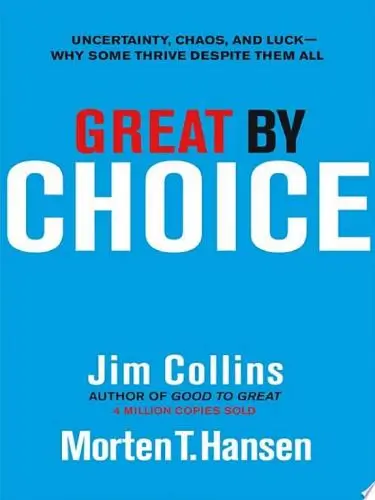Leading Change
What's it about?
Leading Change introduces an 8-step process for leading successful organizational change, emphasizing the importance of creating a sense of urgency, building a guiding coalition, and anchoring new approaches in the corporate culture. This book is a must-read for leaders seeking to navigate the complex waters of change in today's fast-paced world, offering practical insights and strategies to transform challenges into opportunities for growth.
About the Author
John P. Kotter, a luminary in change management and leadership, mesmerizes readers with his compelling insights and practical frameworks. Best known for "Leading Change" and the 8-Step Process for Leading Change, Kotter's work is a beacon for navigating organizational transformation. His engaging style blends rigorous research with real-world examples, making the complexities of change accessible and actionable for leaders at all levels.
10 Key Ideas of Leading Change
Establish a Sense of Urgency for Change
Creating a compelling need for change is crucial to mobilize the organization.
This involves identifying potential threats and opportunities, and presenting them in a way that people feel an immediate need to act.
The reasoning behind this tactic is that without a sense of urgency, complacency sets in, making it difficult to garner the support and momentum needed for change.
By highlighting the risks of not changing and the benefits of swift action, leaders can overcome inertia and resistance.
Learn DeeperIdentify the Threats and Opportunities: Start by conducting a thorough analysis of your environment. Look into market trends, competitor behavior, technological advancements, and internal performance metrics. This will help you pinpoint the exact threats that could harm your organization and the opportunities you might be missing out on.
Communicate Effectively: Once you've identified the threats and opportunities, craft a clear and compelling message that highlights the urgency of the situation. Use stories, data, and visuals to make your case more persuasive. Remember, the goal is to make the need for change feel immediate and important.
Engage Stakeholders: Get key stakeholders involved early in the process. This includes employees, management, and possibly even customers or partners. Their input can provide valuable insights and help refine your approach. Plus, involving them early helps build buy-in and reduce resistance.
Create Quick Wins: Identify small, achievable goals that align with the larger change initiative. Achieving these quick wins can build momentum and demonstrate the benefits of change, making it easier to tackle larger, more challenging aspects of the transformation.
- Example
A retail company notices a steady decline in in-store sales while their online competitors are growing. The leadership team conducts a market analysis and realizes that they're losing market share due to their lack of an online presence. They present this finding to the company, highlighting the risk of continuing business as usual and the opportunity of expanding into e-commerce. By showing potential revenue growth from online sales, they create a sense of urgency around digital transformation.
- Example
A manufacturing firm discovers through employee feedback and declining productivity metrics that outdated technology and inefficient processes are leading to low morale and high turnover rates. The leadership decides to act by clearly communicating these findings to all employees, explaining how modernizing operations could improve working conditions and secure the company's future. They involve employees in the solution-finding process and commit to quick improvements, demonstrating early successes to build support for broader changes.
Form a Powerful Coalition to Guide the Change
Change cannot happen in isolation; it requires the support and leadership of a strong coalition.
This group should consist of influential individuals within the organization who have the respect, expertise, and credibility to drive change.
The rationale is that a diverse coalition provides the necessary leadership, authority, and communication channels to effectively guide the change process, ensuring that initiatives are not siloed but supported across the organization.
Learn DeeperIdentify Key Players: Start by making a list of individuals within your organization who have a mix of influence, expertise, and credibility. Think about those who are respected by their peers and can champion new ideas effectively.
Build Relationships: Before forming your coalition, invest time in building or strengthening relationships with these key players. Understand their perspectives, motivations, and how the change aligns with their goals.
Communicate the Vision: Clearly articulate the vision and objectives of the change you're advocating for. Ensure that every member of the coalition understands the importance of the change and how it benefits the organization as a whole.
Leverage Diverse Strengths: Recognize and utilize the diverse strengths and skills within your coalition. Assign roles and responsibilities that play to each member's strengths, ensuring a comprehensive approach to driving change.
Maintain Open Communication: Keep the lines of communication open within your coalition. Regular meetings, updates, and feedback sessions can help maintain momentum and address any challenges promptly.
- Example
A tech company looking to shift its product strategy forms a coalition consisting of senior engineers, marketing leaders, and customer support managers. Together, they develop a comprehensive plan to realign the company's product offerings with market demands, leveraging their combined expertise.
- Example
A non-profit organization aiming to expand its outreach efforts creates a coalition of board members, volunteers, and community leaders. This group works collaboratively to identify new opportunities for engagement and to streamline the process for launching new programs.
Create a Vision for Change to Direct Efforts
A clear and compelling vision serves as a roadmap for change, providing direction and inspiring action.
It should articulate the future state in a way that is understandable, desirable, and achievable.
The importance of a vision lies in its ability to align efforts, motivate stakeholders, and provide a common goal.
Without a clear vision, change efforts can become disjointed and lose focus, leading to wasted resources and diminished morale.
Learn DeeperDefine Your Vision Clearly: Start by taking the time to reflect on what you want to achieve. Write down your vision in simple, clear language that can easily be communicated to others. Think about the end goal and what success looks like.
Communicate Your Vision: Once you have a clear vision, share it with your team, colleagues, or stakeholders. Use stories or examples to make it relatable and inspiring. Regular communication is key to keeping the vision alive and at the forefront of everyone's mind.
Align Actions with the Vision: Review current processes, projects, and tasks to ensure they align with the vision. If something doesn't contribute to the vision, consider whether it's necessary or if it can be adapted to better serve the ultimate goal.
Celebrate Milestones: As you make progress towards your vision, celebrate the milestones. This not only acknowledges the hard work but also keeps the team motivated and focused on the vision.
- Example
A tech startup founder envisions creating an app that makes mental health resources accessible to everyone. They clearly define this vision and communicate it to their team, ensuring all features developed align with making resources accessible and user-friendly. They celebrate when the app reaches download milestones, reinforcing the vision's importance.
- Example
A school principal aims to transform their school into a nurturing environment that fosters creativity and critical thinking. They articulate this vision in staff meetings, newsletters, and community gatherings. They encourage teachers to integrate creative projects and critical thinking exercises into their curriculum, and they recognize classes that exemplify these values.
Communicate the Vision Widely and Effectively
Once a vision is established, it must be communicated frequently and powerfully across the entire organization.
This involves using every vehicle possible to spread the message, from formal presentations to informal discussions.
Effective communication ensures that everyone understands the vision, sees its value, and knows their role in achieving it.
The key is to communicate in a way that is engaging, inclusive, and responsive to feedback, fostering a culture of openness and participation.
Learn DeeperIdentify Your Communication Channels: Start by listing all the ways you can communicate within your organization. This could include email, team meetings, internal newsletters, and social media platforms. Don't overlook informal channels like coffee breaks or casual conversations.
Craft Your Message Carefully: Make sure your message about the vision is clear, concise, and compelling. Use stories or examples to illustrate your points and make the vision relatable. Tailor your message to suit different audiences within the organization to ensure it resonates with everyone.
Schedule Regular Updates: Communication shouldn’t be a one-off event. Plan regular updates to keep the vision fresh in everyone's mind. This could be through monthly meetings, weekly emails, or even quick daily stand-ups for project teams directly involved in the change.
Encourage Feedback and Dialogue: Create opportunities for people to ask questions, express concerns, and offer suggestions related to the vision. This could be through Q&A sessions, suggestion boxes, or interactive workshops. Listening and responding to feedback shows that you value everyone’s input and are committed to inclusive change.
Lead by Example: Demonstrate your commitment to the vision in your daily actions. When leaders visibly align their behavior with the vision, it sends a powerful message and encourages others to follow suit.
- Example
A tech company launching a new sustainability initiative uses its monthly all-hands meeting to introduce the vision, followed by smaller team meetings where employees can discuss what the initiative means for their work. They also launch an internal blog series featuring stories from employees who are leading by example.
- Example
A retail chain undergoing a digital transformation creates a series of short, engaging videos featuring the CEO explaining the vision and its importance. These are shared on the company’s intranet and followed up with departmental workshops to brainstorm how each area can contribute to the transformation.
Empower Employees to Act on the Vision
Empowering employees means removing barriers to change, such as outdated processes, hierarchical structures, or cultural norms that stifle innovation.
It also involves providing the necessary resources, training, and support to enable action.
Empowerment is critical because it leverages the talents and energies of all employees, encouraging initiative and ownership.
When people feel empowered, they are more likely to contribute ideas and work towards the vision with enthusiasm.
Learn DeeperIdentify and Remove Obstacles: Start by identifying any processes, structures, or cultural norms within your organization that may be hindering change. Once identified, work collaboratively to find ways to remove or modify these barriers.
Provide Necessary Resources and Training: Ensure that employees have access to the tools, resources, and training they need to effectively contribute to the vision. This might include workshops, seminars, or access to new technologies.
Encourage Open Communication: Foster an environment where employees feel comfortable sharing their ideas and concerns. Regular meetings, suggestion boxes, and open-door policies can help facilitate this.
Recognize and Reward Contributions: Acknowledge and reward employees who take initiative and contribute towards achieving the vision. This could be through formal recognition programs, bonuses, or even simple thank-you notes.
- Example
A tech company identifies that its rigid hierarchical structure is slowing down innovation. To empower employees, it introduces cross-functional teams where members from different departments collaborate on projects, breaking down silos and encouraging a more dynamic exchange of ideas.
- Example
A retail chain realizes that its employees lack the necessary skills to implement a new customer service strategy. The company decides to empower its workforce by providing comprehensive training sessions on customer engagement techniques and equipping them with tablets to access information and services in real-time while assisting customers.
Deeper knowledge. Personal growth. Unlocked.
Unlock this book's key ideas and 15M+ more. Learn with quick, impactful summaries.
Read Full SummarySign up and read for free!
Leading Change Summary: Common Questions
Experience Personalized Book Summaries, Today!
Discover a new way to gain knowledge, and save time.
Sign up for our 7-day trial now.
No Credit Card Needed

Similar Books

Emotional Intelligence at Work
Dalip Singh
Seeing the Big Picture
Kevin Cope
Leadership Is Concept Heavy
Dr. Enoch Antwi
Great by Choice
Jim Collins
The Leader′s Guide to Coaching in Schools
John Campbell
Preparing School Leaders for the 21st Century
Stephan Gerhard Huber
The E-Myth Manager
Michael E. Gerber
Leadership Is Language
L. David Marquet
Start-up Nation
Dan Senor
The Founder's Dilemmas
Noam WassermanTrending Summaries

Peak
Anders Ericsson
Never Split the Difference
Chris Voss
Smart Brevity
Jim VandeHei
The Psychology of Money
Morgan Housel
The First 90 Days
Michael D. Watkins
Atomic Habits
James Clear
Thinking, Fast and Slow
Daniel Kahneman
The Body Keeps the Score
Bessel van der Kolk M.D.
The Power of Regret
Daniel H. Pink
The Compound Effect
Darren HardyNew Books

The Art of Spending Money
Morgan Housel
$100M Offers
Alex Hormozi
A Candle for Kiri
Edna Mae Holm
Principles of Marketing, Global Edition
Gary Armstrong
Serpent Rising: The Kundalini Compendium
Neven Paar
Feeling Is the Secret
Neville Goddard
The 100 Best Business Books of All Time
Jack Covert
My Oxford Year
Julia Whelan
Trading in the Zone
Mark Douglas

